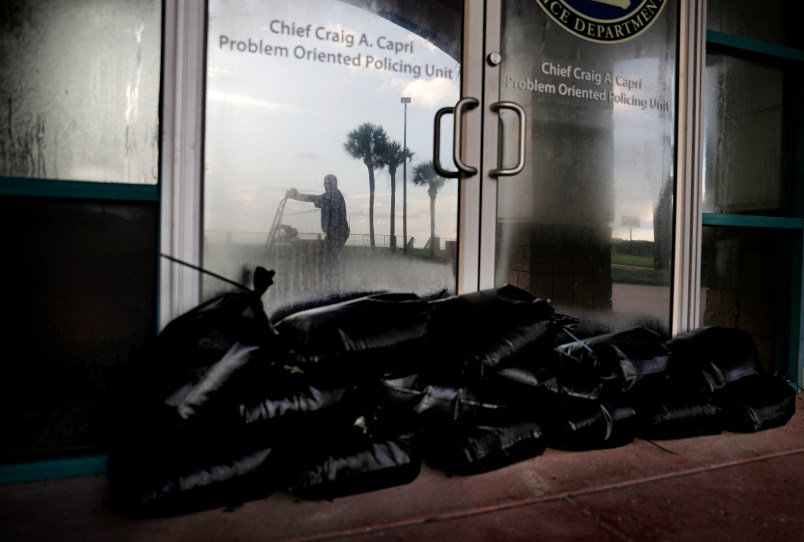MIAMI (AP) — Irma weakened slightly Friday but remained a dangerous and deadly hurricane taking direct aim at Florida, threatening to march along the peninsula’s spine and deliver a blow the state hasn’t seen in more than a decade.
Irma was a Category 4 storm with maximum sustained winds of 150 mph (240 kph) and is forecast to remain at that strength when it comes ashore someplace south of Miami on Sunday. The storm killed at least 20 people in the Caribbean and left thousands homeless as it devastated small islands in its path.
Florida Gov. Rick Scott urged people in coastal and low-lying areas to heed evacuation orders. Across the state, some 850,000 people were ordered to leave their homes, clogging interstates as far north as Atlanta.
Scott said people fleeing could use the shoulder lane on highways, but he hasn’t reversed the southbound lanes. Several small communities around Lake Okeechobee in the south-central part of Florida were added to the evacuation list because the lake may overflow, the governor said.
“You don’t have to go a long way. You can go to a shelter in your county,” Scott said. “This storm is powerful and deadly. We are running out of time.”
The latest forecast shifted the most powerful part of the storm to the west of the Miami metropolitan area that his home to some 6 million people, but hurricane-force winds are still likely there.
“Irma is likely to make landfall in Florida as a dangerous major hurricane, and will bring life-threatening wind impacts to much of the state regardless of the exact track of the center,” the hurricane center said in its forecast.
The last major hurricane — a storm with winds of at least 111 mph (180 kph) — to hit Florida was Wilma in 2005. Its eye cut through the state’s southern third as it packed winds of 120 mph (193 kph). Five people died.
Forecasters predicted a storm surge of 6 to 12 feet above ground level along Florida’s southwest coast and in the Keys. As much as a foot of rain could fall, with isolated spots receiving 20 inches.
Gas shortages and gridlock have plagued the evacuations, turning normally simple trips into tests of will. Interstates 75 and 95 north were bumper-to-bumper, while very few cars and tractor-trailers drove on the south lanes. So far, the Florida governor has not ordered a contra-flow traffic plan.
Carmen Pardo and her 6-year-old daughter, Valeria, drove around Miami for seven hours, from gas station to gas station, frantically searching for somewhere to fill up the tank to evacuate. They found nothing.
“She was saying, ‘Mommy I’m so tired, I can’t do this anymore,'” she said Thursday. “It was craziness.”
Pardo booked the only flight she could find leaving the city, to Orlando, where she reserved two seats on a bus bound for Tallahassee on Friday.
“It’s the beginning of an adventure,” she said.
The National Hurricane Center issued hurricane warnings for the Keys and parts of South Florida and Lake Okeechobee. It added a storm surge warning and extended watch areas wrapping around the tip of the peninsula.
With winds that peaked at 185 mph (300 kph), Irma was the most powerful hurricane ever recorded in the Atlantic.
Georgia Gov. Nathan Deal ordered evacuations for all areas east of Interstate 95, including the city of Savannah, and authorized about 5,000 National Guard members to help with response and recovery.
The last Category 5 storm to hit Florida was Andrew in 1992. Its winds topped 165 mph (265 kph), killing 65 people and inflicting $26 billion in damage. It was at the time the most expensive natural disaster in U.S. history.







This is going to be catastrophic.
This is the scariest graphic I’ve seen that truly represents its enormity.
Note: It’s not over Texas. Shown for scale only.
Also be aware it was only downgraded to a Cat 4
because its winds were 5 mph less than a Cat 5.
It’s also possible it could restrengthen to cat 5, once it“s past Cuba and over more open warm water. This is one big mf’in’ tempest.
Most of the hurricane scientists and modelers are calling that just short of a given. At one point, they’ve said, it would’ve been classified as a Cat 6 but the scale didn’t go that high.
With your permission I’ll go ahead and enter that into the “Understatement of the Year” competition.
The strongest portion of the storm is the northeastern section of the eye wall. If Irma tacks towards the western coast of Florida it means that region will hit Miami like a bullseye. On the other hand, swinging east will mean the ocean takes the brunt of the storm.
If by ocean you mean the northern Bahamas, then yeah.
Given the storm surge they’d get, I think I’d rather Miami took the hit.